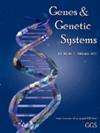The regulatory mechanisms that make mature sperm cells in the mouse.
IF 1
4区 生物学
Q4 BIOCHEMISTRY & MOLECULAR BIOLOGY
引用次数: 0
Abstract
Copyright: ©2022 The Author(s). This is an open access article distributed under the terms of the Creative Commons BY 4.0 International (Attribution) License (https://creativecommons.org/ licenses/by/4.0/legalcode), which permits the unrestricted distribution, reproduction and use of the article provided the original source and authors are credited. In multicellular organisms that reproduce sexually, gametes are the sole type of cells that convey genetic information to the next generation. In mice, the germ cell lineage appears at the epiblast stage of embryogenesis, and is separated from the somatic lineage. The emerging germ cells are called primordial germ cells or PGCs, where methylation in the genomic DNA eventually becomes almost completely erased, transiently making their epigenome profoundly different from that of the somatic cells. Then, in sperm cell precursors called prospermatogonia in embryonic testes, de novo DNA methylation takes place genome-wide. These cells subsequently become spermatogonia with the stem cell activity to proliferate in response to external signals, which underlies the life-long production of spermatozoa. Spermatogonia are unipotent stem cells, and a fraction of them differentiate into spermatocytes, in which the transcriptomic program is switched to execute the special cell division process called meiosis. Meiosis in males produces haploid spermatids, which then differentiate into spermatozoa having specific morphology and highly condensed chromatin. All of these consecutive processes are orchestrated by a number of genes, and a failure in any of them results in infertility. In this issue, we have four review articles written by leading young scientists in mammalian germ cell biology. Kenjiro Shirane describes how DNA methylation The regulatory mechanisms that make mature sperm cells in the mouse小鼠成熟精子细胞产生的调控机制。
版权所有:©2022作者。这是一篇根据知识共享BY 4.0国际(归因)许可条款发布的开放获取文章(https://creativecommons.org/licenses/by/4.0/legalcode),允许不受限制地分发、复制和使用文章,前提是原始来源和作者得到认可。在有性繁殖的多细胞生物中,配子是向下一代传递遗传信息的唯一类型的细胞。在小鼠中,生殖细胞谱系出现在胚胎发生的成表细胞阶段,并与体细胞谱系分离。新兴的生殖细胞被称为原始生殖细胞或PGCs,基因组DNA中的甲基化最终几乎完全被抹去,短暂地使其表观基因组与体细胞的表观基因组截然不同。然后,在胚胎睾丸中被称为前原细胞的精子细胞前体中,从头开始的DNA甲基化在全基因组范围内发生。这些细胞随后成为具有干细胞活性的精原细胞,以响应外部信号而增殖,这是精子终身生产的基础。精原细胞是单能干细胞,其中一部分分化为精母细胞,在精母细胞中,转录组程序被切换以执行称为减数分裂的特殊细胞分裂过程。雄性减数分裂产生单倍体精子,然后分化为具有特定形态和高度浓缩染色质的精子。所有这些连续的过程都是由许多基因协调的,其中任何一个基因的失败都会导致不孕。在本期中,我们有四篇由哺乳动物生殖细胞生物学领域的顶尖年轻科学家撰写的综述文章。Shirane Kenjiro描述了DNA甲基化是如何在小鼠体内形成成熟精子细胞的调节机制
本文章由计算机程序翻译,如有差异,请以英文原文为准。
求助全文
约1分钟内获得全文
求助全文
来源期刊

Genes & genetic systems
生物-生化与分子生物学
CiteScore
1.50
自引率
0.00%
发文量
22
审稿时长
>12 weeks
期刊介绍:
Genes & Genetic Systems , formerly the Japanese Journal of Genetics ,
is published bimonthly by the Genetics Society of Japan.
 求助内容:
求助内容: 应助结果提醒方式:
应助结果提醒方式:


